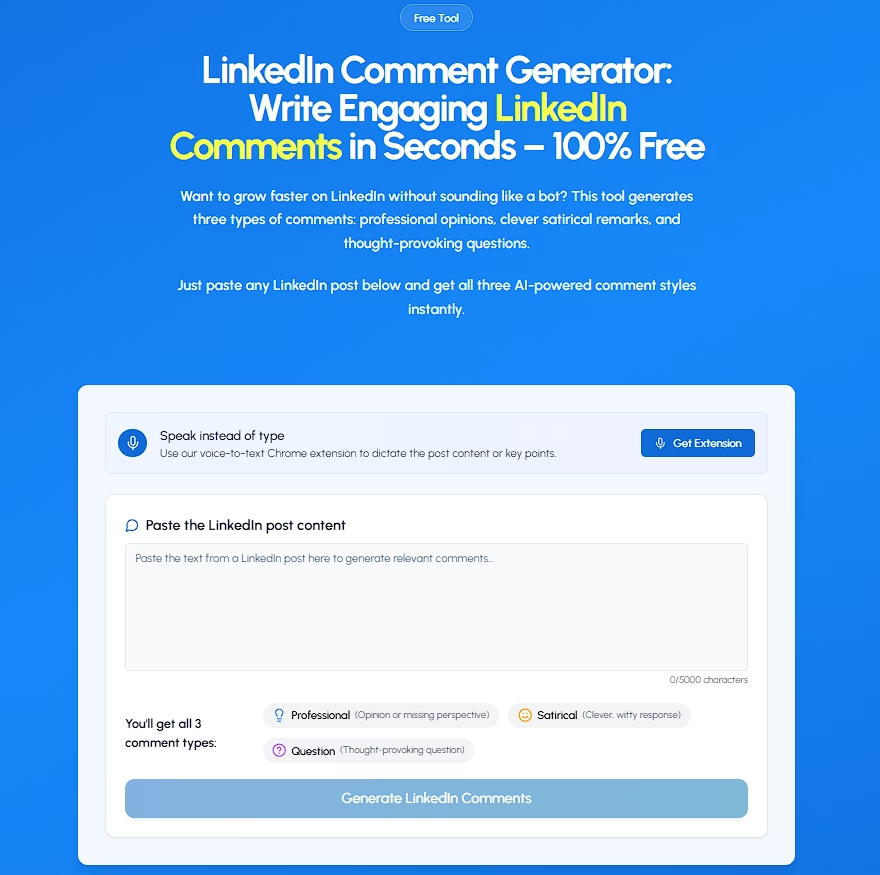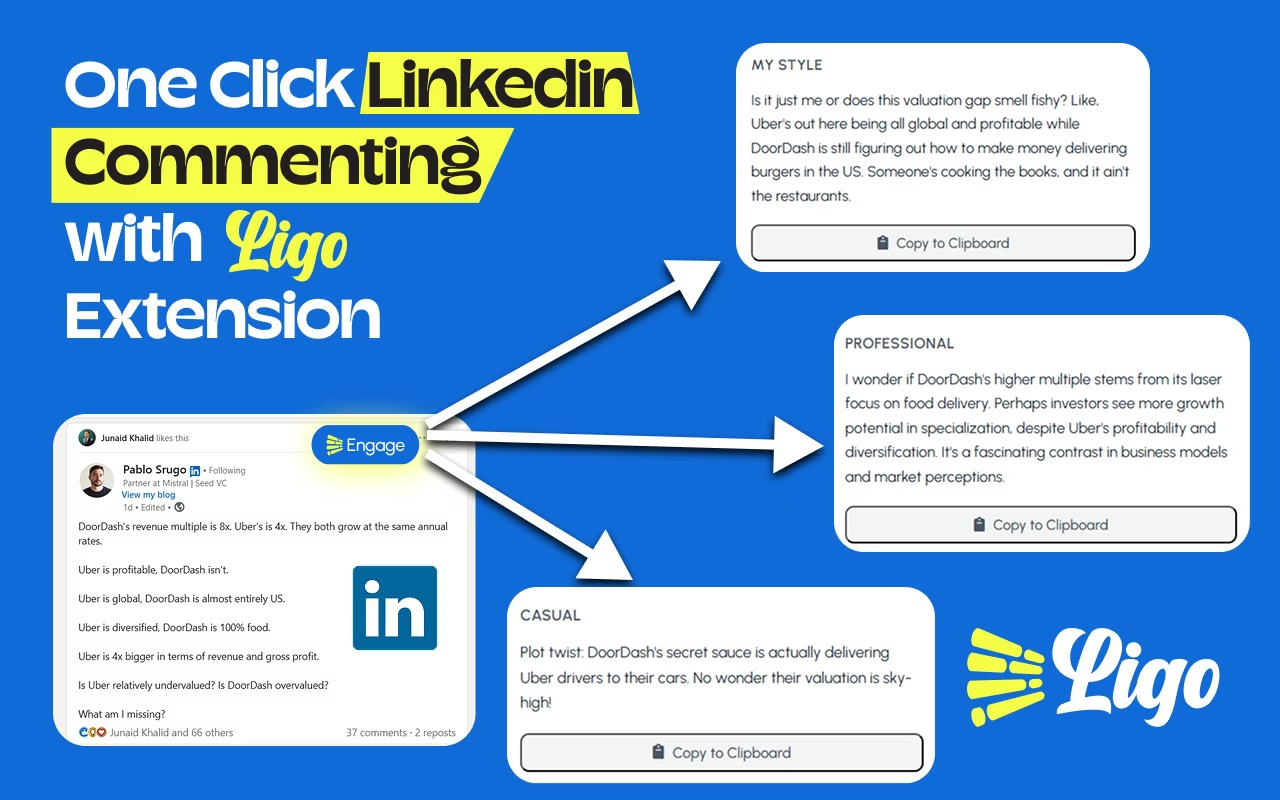I’ll be blunt: I used to hate writing comments.
Not because I didn’t have thoughts - I had plenty - but because the blank box on every LinkedIn post felt like a tiny test I hadn’t studied for. Do I sound useful? Do I sound spammy? Will this start a real talk, or be another forgotten line?
That’s why I tried LiGo’s linkedin comment generator.
And here’s what I learned: AI can do the heavy lifting, but it shouldn’t write the final line for you. Used right, it frees your headspace so you can add the real human bit that matters. The tool itself gives three clear comment styles (professional opinion, satirical, and question), works in the browser with a Chrome extension, and is free to try - which makes testing it low risk.
Below I’ll walk you through the idea I care about most: authenticity in automation. I’ll show how I use the LiGo linkedin comment generator as a starting point, how I tweak the AI output so it sounds like me, and the simple rules I follow so every comment I leave actually helps my network.

Why a comment matters more than most people think
Comments show up in more feeds than posts do. They bump you in front of the poster’s network, they let you start short conversations, and they’re a quick way to build authority without writing a full post.
LiGo’s own page sums this up: comments boost visibility, build authority, and help start real conversations - when they’re good.
That’s the catch: most comments are not good. They’re either:
- A single emoji, or
- A generic “Great post!” or
- A long “me too” that doesn’t add value.
A little time spent on a short, helpful reply is one of the smartest returns on your time on LinkedIn. But that still leaves the blank-box problem. Enter the generator.
What the tool actually does
I’ll keep this short and factual: paste a LinkedIn post into the tool, pick a tone, and you’ll get several comment suggestions.
The LiGo tool offers three main styles and a Chrome extension to generate comments inside LinkedIn while you browse. It also gives personalization hints based on how you or your team normally comment. That last part is what keeps the output from sounding like a robot.
Why that matters: the generator handles the first draft - the part of the job that drains your energy.
You then add the human details: a short example, a mention of the poster’s line, a follow-up question, or a small compliment. That’s the part that starts conversations.
The "Authenticity in Automation" approach I use
Here’s the step-by-step play I follow every time:
- Generate three variants. I pick the tone that matches me: Insightful (professional), Clever (satire), or Questioning. The tool gives 3–6 options so I don’t have to guess.
- Pick one and cut it down. AI tends to be wordy. I trim to one or two sentences - short wins.
- Add a tiny human bit. A quick line of context: “As someone who’s worked on X…” or “I saw this go wrong once when…” This single detail makes the comment feel lived-in.
- Ask a follow-up. A question invites replies. Even a small “How did you handle X?” works.
- Post and watch for replies. If someone answers, I’m ready to reply back - that’s where relationships form.
This workflow keeps me consistent. The generator removes the start-friction, and I do the rest. That’s authenticity in automation.

Real examples (so you can copy the method)
Imagine the post: “We shipped a small update to our onboarding flow - fewer steps, better success rates.”
AI professional (raw):
“Congrats on the update - streamlining onboarding is key to retention.”
My edit (humanized):
“Nice work - fewer steps really help. I once cut onboarding by one screen and saw activation jump 14%. Curious - how did you measure success here?”
AI question (raw):
“Interesting. How did you measure the improvement?”
My edit (humanized):
“Nice update. Did you A/B test the new flow, or did you roll it out to everyone at once?”
See the pattern? The AI gives a strong, neutral start. I add a short real detail or a clean question. That tiny extra makes the comment feel like it came from a real person, not a script.
Common worries - and why they’re mostly okay
“It will sound robotic.”
It can. But LiGo trains its suggestions to mimic professional tones, and the extension can personalize suggestions based on comment history. Even so, you should always edit. Treat the AI output like a draft, not the final.
“Isn’t this cheating?”
No. The tool helps you be consistent and saves time. The real work is still in choosing where to comment and what human bit you add. Using a tool to clear the blank box is smart time management, not fake engagement.
“Will LinkedIn penalize me?”
Not for generating a comment draft. LinkedIn cares about spammy, repeated content and automated posting. If you personalize and post manually, you’re fine.
Tiny edits that make an AI comment sound human (my checklist)
- Remove filler words (“really”, “very”) if they’re not needed.
- Add one small personal detail or short story line (“I used to…”, “We did this once…”).
- Ask one direct, short question.
- Use a first name when relevant.
- Remove em dashes (—)
- Keep it to 1–3 short sentences - people scan fast.
I keep this checklist on a sticky note by my monitor. It takes 10–20 seconds per comment, and it matters.
A short workflow for teams
If you’re running a marketing or sales team, the extension and generator can scale consistent commenting. Here’s a simple team process that works:
- Set voice rules - 3 tone choices and example lines.
- Train the tool - the extension can use comment history for personalization.
- Daily quick session - team members spend 10 minutes replying to relevant posts using the generator.
- Review top replies weekly - keep what works, drop stuff that feels off.
This frees your team to focus on real conversations instead of staring at an empty box.
My small test (personal note)
I tried this for a week. I used the generator to draft comments, edited each with one line of my own, and kept a short follow-up question in mind.
The results weren’t magic overnight, but I found two things: I commented more often, and the replies I got were better. The generator removed the friction; my edits added real value.
That’s the whole point. Tools free your energy. You spend that energy where it actually matters-having the human exchange.
Frequently Asked Questions (FAQ)
Q: Will the generator post automatically?
No - it generates suggestions. With the Chrome extension you can create replies directly inside LinkedIn, but you still control the final post. LiGo
Q: Are the comments free?
The tool page shows the basic comment generator is free to try. Check the tool to see the current limits.
Q: Can I change tone?
Yes - options include Insightful/Supportive/Casual/Questioning and a satirical variant, depending on what fits the post.
Q: Will it sound like everyone else?
It might if you copy-paste the output unchanged. Add one short personal detail and a question to keep your voice unique.
Final thoughts - why I’m comfortable using the linkedin comment generator
I still write my own posts. I still choose where to show up. But the generator clears the hardest bit: getting started. It gives me a good draft, and I add the human part - a tiny story, a question, or a note of help. That keeps my voice intact and makes my comments useful.
If you’re skeptical, try the tool on one post a day for a week. Use the “authenticity in automation” plan: generate, pick, edit, post. You’ll find the time you save goes straight into better conversations.
👉 Try the LiGo linkedin comment generator and use it as a first draft, not the final line.
See linkedin comment generator tool in action here:
Next resources (read next)
- For formatting that helps your posts and comments read better, see LinkedIn Text Formatter: Why Your Posts Are Invisible
- For profile copy that recruiters actually read, try LinkedIn Summary Generator: Why 95% of Summaries Fail
- To fix your About section and get more replies, read LinkedIn About Generator: Your Profile Is Costing You Jobs




